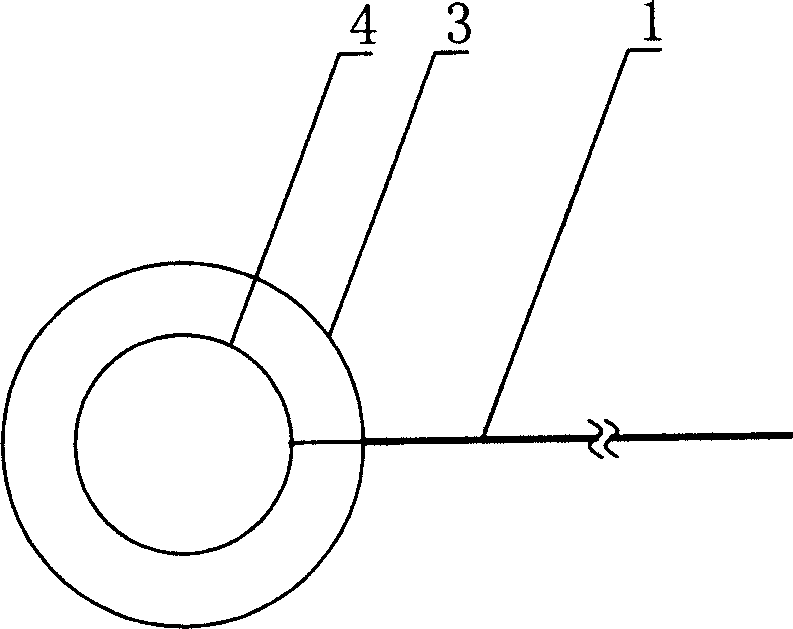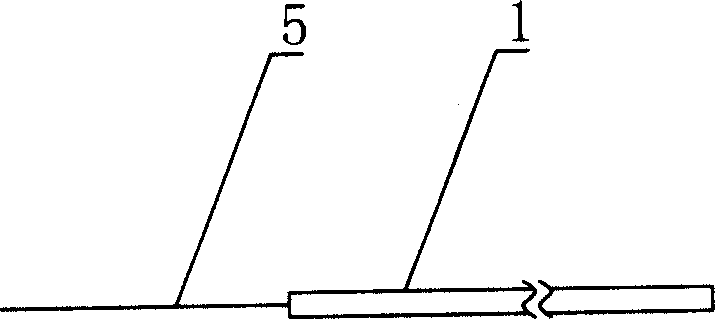Microelectrode for recording laboratory animal visual sense electrophysiological reaction
A technology of micro-electrodes and experimental animals, which is applied in applications, eye testing equipment, medical science, etc., can solve problems such as easy drift, difficult fixation, large deviation of measurement results, etc., and achieve stable output signals, good repeatability, and record waveforms stable effect
- Summary
- Abstract
- Description
- Claims
- Application Information
AI Technical Summary
Problems solved by technology
Method used
Image
Examples
Embodiment 1
[0043] The recording electrode is a ring-shaped corneal contact electrode, the reference electrode and the ground electrode are needle electrodes, and the experimental animal is a rabbit.
[0044] Drop methylcellulose (or ofloxacin eye ointment) on the corneal surface of rabbit eyes, place the internal / external electrodes with double-circle contact electrodes with diameters of 3mm / 5mm respectively after the corneal surface is anesthetized, and use needles for reference electrodes and ground electrodes. Electrodes were inserted into the ipsilateral ear and the top of the head, respectively.
[0045] Using the above-mentioned miniature electrodes, in cooperation with the LKC UTAS-2000 electrophysiological instrument in the United States, the dual-channel ERG is recorded, and the recorded waveform is as follows: Figure 4 shown.
[0046] It can be seen from the figure that there is basically no interference clutter (that is, no steep peak) in the a→b segment of the displayed wav...
Embodiment 2
[0048] The recording electrode is a ring-shaped corneal contact electrode, the reference electrode and the ground electrode are needle electrodes, and the experimental animals are BN (Brown Norway) rats.
[0049] The recording electrode adopts a 0.8mm / 1.5mm double-circle contact electrode, which is placed directly into the eyeball after the animal is anesthetized. The surface is dripped with physiological saline or methylcellulose, and the reference electrode and the ground electrode are needle electrodes, which are respectively inserted into the same side of the ear. and top of head.
[0050] Using the above-mentioned miniature electrodes, in cooperation with the LKC UTAS-2000 electrophysiological instrument in the United States, the dual-channel ERG is recorded, and the recorded waveform is as follows: Figure 5 shown.
[0051] It can be seen from the figure that the segment N1→O4 in the displayed waveform curve has no interference clutter, and the waveform curve is relativ...
Embodiment 3
[0054] The recording electrode, the reference electrode and the grounding electrode are metal needle-shaped electrodes with a 1ml stainless steel needle for injection as the needle tip, and the experimental animals are Wistar rats.
[0055] The recording electrode was inserted under the skin connecting the two ears, and the reference electrode and the grounding electrode were inserted into the ipsilateral ear and the top of the head respectively.
[0056] Get the FVEP record waveform as Image 6 shown.
[0057] It can be seen from the figure that the displayed waveform curve has no clutter interference, and the waveform is stable, reflecting the advantages of the technical solution, which is convenient and accurate in positioning, easy to fix, good in contact, stable in recorded waveform, and good in repeatability of the recorded waveform.
[0058] All the other are with embodiment 1 or 2.
PUM
 Login to View More
Login to View More Abstract
Description
Claims
Application Information
 Login to View More
Login to View More - R&D
- Intellectual Property
- Life Sciences
- Materials
- Tech Scout
- Unparalleled Data Quality
- Higher Quality Content
- 60% Fewer Hallucinations
Browse by: Latest US Patents, China's latest patents, Technical Efficacy Thesaurus, Application Domain, Technology Topic, Popular Technical Reports.
© 2025 PatSnap. All rights reserved.Legal|Privacy policy|Modern Slavery Act Transparency Statement|Sitemap|About US| Contact US: help@patsnap.com



